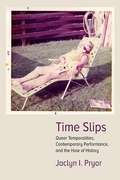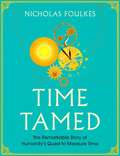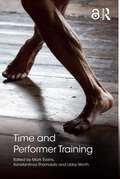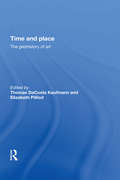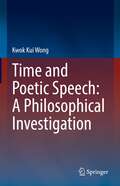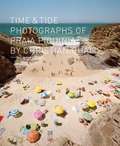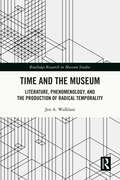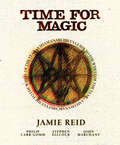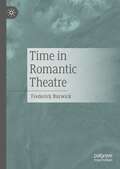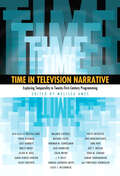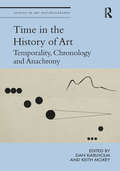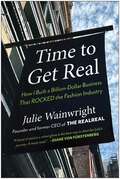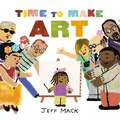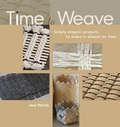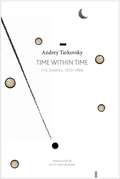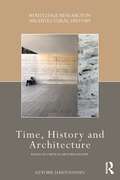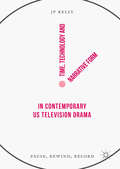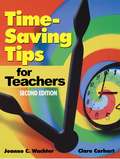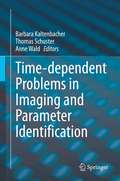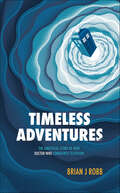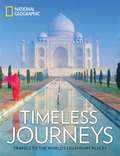- Table View
- List View
Time Slips: Queer Temporalities, Contemporary Performance, and the Hole of History
by Jaclyn I. PryorPryor illuminates how each artist deploys performance as a tool to render history visible, trauma recognizable, and transformation possible by laying bare the histories and ongoing systems of violence woven deep into our society.
Time Tamed
by Nicholas FoulkesFor more than 25,000 years, mankind has sought to understand and measure the passing of time, in the process creating some of the most remarkable and beautiful timepieces. Now, in Nicholas Foulkes's lavishly illustrated book, the battle to tame time is brought vividly to life. From the baboon bone dating back to the palaeolithic era that marked the lunar cycle and on to the 3500-year-old water clock at Karnak, from our earliest days mankind has sought to track the passing of time. More recently, the struggles to measure longitude and to create a workable train timetable across the vast, open expanse of the United States have inspired new developments. In Time Tamed, Nicholas Foulkes reveals how we have done this by focusing on some of the most significant developments in timekeeping across the ages. He also highlights the most stunning and lavish clocks and watches in history - from Big Ben to Rolex - for telling the time has never been purely about function, but also about design. The book is filled with remarkable tales, from the 14th century monk in St Albans who created one of the first mechanical clocks to the Holy Roman Emperor who built a clock into an automated ship that fired a cannon to summon guests to dinner. More recently, there was the Surrey woman who used a Napoleonic era watch to 'deliver' the accurate time to London shopkeepers in the wartime era of Churchill, or the Swiss denture maker who solved a tricky problem for the Indian Raj's polo players. Time Tamed is a book you'll want to spend many hours enjoying.
Time Warped
by Bruce BergerTime Warped is a book of five read-aloud plays that stretch the truth about the past. With plays such as “Renaissance Reform School” and “The Idiodyssey,” this book will have students laughing as they try to decipher what is real and what is not.Each play includes follow-up activities for writing, discussion, and research.
Time and Performer Training
by Mark Evans Libby Worth Konstantinos ThomaidisTime and Performer Training addresses the importance and centrality of time and temporality to the practices, processes and conceptual thinking of performer training. Notions of time are embedded in almost every aspect of performer training, and so contributors to this book look at: age/aging and children in the training context how training impacts over a lifetime the duration of training and the impact of training regimes over time concepts of timing and the ‘right’ time how time is viewed from a range of international training perspectives collectives, ensembles and fashions in training, their decay or endurance. Through focusing on time and the temporal in performer training, this book offers innovative ways of integrating research into studio practices. It also steps out beyond the more traditional places of training to open up time in relation to contested training practices that take place online, in festival spaces and in folk or amateur practices. Ideal for both instructors and students, each section of this well-illustrated book follows a thematic structure and includes full-length chapters alongside shorter provocations. Featuring contributions from an international range of authors who draw on their backgrounds as artists, scholars and teachers, Time and Performer Training is a major step in our understanding of how time affects the preparation for performance.
Time and Place: The Geohistory of Art
Authors from Herodotus in antiquity to Vasari in the Renaissance related art and architecture to peoples, nations, regions, cities, and environments. Already with Winckelmann and the origins of discussion of art history in the eighteenth century geography was seen as a powerful determinant of art. In the nineteenth century, the perceived connection between nations or races and art flourished, mainly because of the rise of nationalism. Around 1900 the method of geographical analysis received a modern name, 'Kunstgeographie'. But the ideology of 'Blut and Boden' associated with Nazism and related ideologies brought the geography of art into disrepute. This book proposes to return anew to the approach of artistic geography, which had been largely neglected from the Second World War until recently, and to reevaluate the possibilities it provides through a selection of case studies that discuss the connection between art and its place. The introduction and first essay deal with the historiography of the geography of art. Five essays take up specific questions ranging from France and the Low Countries to Mexico and China. The final three essays consider contemporary and broader theoretical issues concerning art in time and place.
Time and Poetic Speech: A Philosophical Investigation
by Kwok Kui WongThis book analyzes the relation between the flow time and poetic speech in drama and rhetoric. It begins with the classical understanding of time as flux, and its problems and paradoxes entailing from Aristotle, Augustine, Kant and Husserl. The reader will see how these problems unfold and find resolutions through dramatic speech and rhetoric which has an essential relation to the flow of time. It covers elements in poetic speech such as affect, rhythm, metaphor, and syntax. It uses examples from classical rhetorical theories by Aristotle, Cicero, Quintilian, dramatic speeches from Shakespeare, as well as other modern dramatic texts by Chekhov, Beckett, Jelinek and Sarah Kane. This book appeals to students and academic researchers working in the philosophical fields of aesthetics and phenomenology as well those working in theater and the performing arts.
Time and Tide
by Jen Bekman Christian ChaizeFeaturing colorful beach umbrellas and dreamy blue horizons, this beautiful oversized book offers a breath of fresh air and evokes fantasies of Mediterranean travel. Photographer Christian Chaize returned many times over the course of eight years to shoot an intimate beach in the south of Portugal from the same vantage point. The resulting photographs provide an enchanting portrait of the tides, light, weather, and people that shape and reshape the landscape each day. A charming and thought-provoking meditation, Time and Tide will appeal to anyone who loves the beach or appreciates the miracle of close looking inherent in photography.
Time and the Museum: Literature, Phenomenology, and the Production of Radical Temporality (Routledge Research in Museum Studies)
by Jen A. WalklateTime and the Museum: Literature, Phenomenology, and the Production of Radical Temporality, is the first explicit in-depth study of the nature of museum temporality. It argues as its departure point that the way in which museums have hitherto been understood as temporal in the scholarship - as spaces of death, othering, memory and history - is too simplistic, and has resulted in museum temporality being reduced to a strange heterotopia (Foucault) - something peculiar, and thus black boxed. However, to understand the ways in which museum temporalities and timescapes are produced, and the consequences that these have upon display and visitor response, is crucial, because time is itself a political entity, with ethical consequence. Time and the Museum highlights something we all experience in some way - time - as a key ethical and political feature of the museum space. Utilizing the fields of literature and phenomenology, the book examines how time is experienced and performed in the public areas of three museum spaces within Oxford - the Ashmolean, Pitt Rivers, and Oxford University Museum of Natural History. Using concepts such as shape, structure, form, presence, absence, authenticity and aura, the book argues for a reconsideration of museum time as something with radical potential and political weight. It will appeal to academics and postgraduate students, especially those engaged in the study of museums, culture, literature and design.
Time for Magic: A Shamanarchist's Guide to the Wheel of the Year
by Philip Carr-Gomm John Marchant Jamie Reid Stephen EllcockPunk meets Druidry in the only trade edition of Jamie Reid's art, weaving c.180 radical art images into the structure of the pagan Wheel of the Year. The art is selected and introduced by curator Stephen Ellcock with notes on the seasonal celebrations by former Chief Druid of OBOD Philip Carr-Gomm.Time for Magic offers an entrancing overview of Jamie Reid&’s incredible art, structured around the eight seasonal festivals of the Wheel of the Year (the equinoxes and solstices plus Imbolc, Beltane, Lughnasadh and Samhain). Jamie observed these festivals, holding rituals at his allotment in Liverpool, and focused on this theme in his later paintings. This book features key Wheel of the Year artworks as well as famous earlier pieces, including the pre-punk, Situationist-inspired agit-prop and the work he produced for the Sex Pistols. Curator Stephen Ellcock has selected the art and in his own inimitable creative style arranged it into season-themed chapters, as well as finding images of Druidic ceremonies held by Jamie&’s great-uncle, Chief Druid George Watson MacGregor Reid.Stephen Ellcock in conversation with John Marchant introduces Jamie&’s life, legacy and love of making trouble; John Marchant provides captions giving deep insight in Jamie&’s work; and Philip Carr-Gomm writes about the Wheel of the Year and how it can help us find a new way of being in this era of climate crisis.
Time in Romantic Theatre
by Frederick BurwickThe shift in temporal modalities of Romantic Theatre was the consequence of internal as well as external developments: internally, the playwright was liberated from the old imperative of “Unity of Time” and the expectation that the events of the play must not exceed the hours of a single day; externally, the new social and cultural conformance to the time-keeping schedules of labour and business that had become more urgent with the industrial revolution. In reviewing the theatre of the Romantic era, this monograph draws attention to the ways in which theatre reflected the pervasive impact of increased temporal urgency in social and cultural behaviour. The contribution this book makes to the study of drama in the early nineteenth century is a renewed emphasis on time as a prominent element in Romantic dramaturgy, and a reappraisal of the extensive experimentation on how time functioned.
Time in Television Narrative: Exploring Temporality in Twenty-First Century Programming
by Melissa AmesThis collection analyzes twenty-first-century American television programs that employ temporal and narrative experimentation. These shows play with time, slowing it down to unfold narrative through time retardation and compression. They disrupt the chronological flow of time itself, using flashbacks and insisting that viewers be able to situate themselves in both the present and the past narrative threads. Although temporal play has existed on the small screen prior to the new millennium, never before has narrative time been so freely adapted in mainstream television. The essayists offer explanations for not only the frequency of time-play in contemporary programming, but also the implications of its sometimes disorienting presence.Drawing upon the fields of cultural studies, television scholarship, and literary studies, as well as overarching theories concerning postmodernity and narratology, Time in Television Narrative offers some critical suggestions. The increasing number of television programs concerned with time may stem from any and all of the following: recent scientific approaches to quantum physics and temporality; new conceptions of history and post history; or trends in late-capitalistic production and consumption, in the new culture of instantaneity, or in the recent trauma culture amplified after the September 11 attacks. In short, these televisual time experiments may very well be an aesthetic response to the climate from which they derive. These essays analyze both ends of this continuum and also attend to another crucial variable: the television viewer watching this new temporal play.
Time in the History of Art: Temporality, Chronology and Anachrony (Studies in Art Historiography)
by Keith Moxey Dan KarlholmAddressed to students of the image—both art historians and students of visual studies—this book investigates the history and nature of time in a variety of different environments and media as well as the temporal potential of objects. Essays will analyze such topics as the disparities of power that privilege certain forms of temporality above others, the nature of temporal duration in different cultures, the time of materials, the creation of pictorial narrative, and the recognition of anachrony as a form of historical interpretation.
Time to Create: Hands-On Explorations in Process Art for Young Children
by Christie BurnettForget stuffy, structured craft activities; your child needs time to create!Rather than merely teaching your child to name colors and to hold a pencil, the hands-on process art experiences in Time to Create encourage discovery through a variety of art media, including drawing, painting, print making, collage, and sculpture.With ideas for encouraging creativity, advice for choosing the right art project, and suggestions for minimizing the mess, you and your child will be on your way to fun-to-do art explorations in no time!Christie Burnett is the writer and founder of the popular Australian parenting blog Childhood 101. She has worked as an early childhood educator for many years and is the mother of two young girls.
Time to Draw Deck: 45 Creative Exercises
by Alyssa Annette BlockThis handy deck of drawing prompts delivers just the bite-sized encouragement that beginners crave and makes it easy to start drawing—anytime, anywhere—and keep drawing. A regular drawing practice improves so much more than technique—it also boosts your self-awareness and productivity. Serving up bite-sized creative prompting in a convenient, display-worthy package, this deck offers 45 inspiring exercises that encourage doodlers, sketchers, and artists of all levels to develop a regular drawing habit.The cards offer a mix of prompts to improve focus, practice skills, or break through blocks and experiment. Keep the deck by your desk and pull a card at random, choose a card every week for a year, or toss the deck in a bag as screen-free entertainment for travel or group gatherings. Whether you're just starting your creative journey or you're ready to shake up an existing drawing practice, these activities will help you integrate the joys and benefits of drawing into your everyday life.CONVENIENT AND EASY TO USE: Keep this deck close at hand for easy anytime creativity. Housed in a sturdy slipcase, these cards are easily stored on your desk or bookshelf yet compact enough to pack in a bag for on-the-go creative prompting. Each card includes a suggested length of time for the activity, so it's easy to choose a card based on the amount of time you have, and most activities are easily accomplished in any setting. On the phone? Long flight? Need a five-minute de-stressing session? There's a card for that! MIX & MATCH FOR MORE VARIETY: The cards are color-coded into three categories: Skills, Focus, and Fun. Choose a card by category or select one card from each category and combine the prompts (for example, mix Skills and Focus) for even more variety! FOR ALL SKILL LEVELS: These exercises are inspired by traditional art school assignments, meditation and art therapy practices, and the professional techniques artists and cartoonists rely on to stay open and curious. Whether you're a seasoned artist looking to expand your horizons or a casual doodler looking for low-pressure drawing activities, this deck makes it easy and fun to build up skills and stretch your creative muscles, at your own pace.EXCELLENT BOREDOM BUSTER: Whether traveling or stuck inside on a rainy day, these playful drawing activities are a perfect way to bust boredom with a little analog creative fun.Perfect for:Art students, aspiring artists, and anyone who wants to engage their creative sidePeople who love adult coloring and other forms of mindful creativityCreative, screen-free group entertainment for gatherings with friends or familyAn entertaining gift for birthday, graduation, holiday, or vacation travelStuffing into a stocking or pairing with a set of pencils, markers, or a how to draw book
Time to Get Real: How I Built a Billion-Dollar Business That Rocked the Fashion Industry
by Julie WainwrightPart tell-all memoir and part entrepreneur crash course, the founder of The RealReal offers an emboldening story of perspective and triumph When she was 52, a recruiter told Julie Wainwright that her failure as CEO of Pets.com made her unemployable. But she proved him—and Silicon Valley—wrong and built her company from an idea into the world&’s largest resource for authenticated luxury resale. Since its launch in 2011, The RealReal has changed the world of fashion forever, making luxury items more accessible and sustainable. Time to Get Real spills the tea on the entrepreneurial journey from a woman&’s perspective and includes all the lessons learned and mistakes made along the way to a billion-dollar business and public company.. This is the book Julie wished she had when she was in the trenches—one that shares the whole exhilarating, stressful, glorious, messy truth about success. Time to Get Real isn&’t just about Julie&’s wild ride through Silicon Valley; it will also show you how to: Build a business from the ground up Hire for startups while avoiding common oversights Overcome workplace bias and adversity Be a shark—and create a unicorn With Julie&’s inspirational story and hard-earned wisdom, this is the perfect read for anyone who has ever imagined starting a company, loves fashion, or wants an uncensored glimpse behind the scenes from a woman who succeeded in spite of it all.
Time to Make Art
by Jeff MackDoes art have to be perfect? Where do you begin? This inspiring picture book about making art doubles as an introduction to the multifaceted and diverse global history of art empowering readers to get creative.Awed by the endless possibilities, a young girl begins asking meaningful questions about creating art. Her questions are answered by a diverse group of artists throughout time and history: from the earliest cave painters to the most recent digital illustrators. Rethinking the familiar Western European timeline of art history, this book introduces readers to diverse works from every era and continent in a playful and inspiring way.Making both art history and art making accessible to all, Time to Make Art nourishes creativity, encouraging young readers to see the artist in themselves.
Time to Scrap: Techniques for Fast, Fun and Fabulous Scrapbook Layouts
by Kathy FesmireScrap it fast, fun, frugal & fabulous! Make scrapbooking your treasured memories quick and easy on your wallet. InTime to Scrap, Memory Makers Master Kathy Fesmire shows you dozens of techniques and shortcuts to save you time and money while still creating fabulous layouts you can be proud of. Ideas include using common household items to stamp, piecing together scraps to form embellishments and adding the look of handstitching to your layout, without the needle and thread. Inside you'll find: Step-by-step demonstrations of innovative scrapbooking techniques that will make your layouts pop 120 eye-catching layouts that are sure to inspire A clock with each layout indicating how long each will take to complete Page sketches you can use for your own fabulous layout design
Time to Weave: Simply Elegant Projects To Make In Almost No Time
by Jane PatrickHighly textured objects such as plaited paper baskets, woven lanterns, small hearth rugs, and cork tables are featured in this beginner's guide to nonloom weaving. The easy instructions teach ancient techniques such as braiding, stringing, and knotting - and call for everyday materials such as copper tape, plastic sheeting, paper yarn, and granite tiles - to produce stunning contemporary designs for the home. A short essay about natural materials and the creative process introduces each project, and lovely photographs showcase the final results: sleek window hangings, stick-and-string coasters, pillows covered in canvas tape, and woven paper cards. A list of resources, an assortment of weaving tips, and suggestions for further reading are included.
Time within Time: The Diaries, 1970–1986
by Andrey Tarkovsky“Tarkovsky for me is the greatest,” wrote Ingmar Bergman. Andrey Tarkovsky only made seven films, but all are celebrated for its striking visual images, quietly patient dramatic structures, and visionary symbolism. Time within Time is both a diary and a notebook, maintained by Tarkovsky from 1970 until his death. Intense and intimate, it offers reflections on Dostoyevsky, Tolstoy, Hermann Hesse, Thomas Mann, and others. He writes movingly of his family, especially his father, Arseniy Tarkovsky, whose poems appear in his films. He records haunting dreams in detail and speaks of the state of society and the future of art, noting significant world events and purely personal dramas along with fascinating accounts of his own filmmaking. Rounding out this volume are Tarkovsky’s plans and notes for his stage version of Hamlet; a detailed proposal for a film adaptation of Dostoyevsky’s The Idiot; and a glimpse of the more public Tarkovsky answering questions put to him by interviewers.
Time, History and Architecture: Essays on Critical Historiography (Routledge Research in Architectural History)
by Gevork HartoonianTime, History and Architecture presents a series of essays on critical historiography, each addressing a different topic, to elucidate the importance of two influential figures Walter Benjamin and Gottfried Semper for architectural history. In a work exploring themes such as time, autonomy and periodization, author Gevork Hartoonian unpacks the formation of architectural history; the problem of autonomy in criticism and the historiographic narrative. Considering the scope of criticism informing the contemporaneity of architecture, the book explores the concept of nonsimultaneity, and introduces retrospective criticism the agent of critical historiography. An engaging thematic dialogue for academics and upper-level graduate students interested in architectural history and theory, this book aims to deconstruct the certainties of historicism and to raise new questions and interpretations from established critical canons.
Time, Technology and Narrative Form in Contemporary US Television Drama: Pause, Rewind, Record
by Jp KellyThis book examines how television has been transformed over the past twenty years by the introduction of new viewing technologies including DVDs, DVRs and streaming services such as Netflix, Hulu and Amazon Prime. It shows that these platforms have profoundly altered the ways we access and watch television, enabling viewers to pause, rewind, record and archive the once irreversible flow of broadcast TV. JP Kelly argues that changes in the technological landscape of television has encouraged the production of narrative forms that both explore and embody new industrial temporalities. Focusing on US television but also considering the role of TV within a global marketplace, the author identifies three distinct narrative temporalities: “acceleration” (24; Prison Break), “complexity” (Lost; FlashForward), and “retrospection” (Mad Men). Through industrial-textual analysis of television shows, this cross-disciplinary study locates these narrative temporalities in their socio-cultural contexts and examines connections between production, distribution, and narrative form in the contemporary television industry.
Time-Saving Tips for Teachers (1-off Ser.)
by Joanne C. Wachter Clare CarhartPerfect for teachers who need help managing their time,Time Saving Tips for Teachers is structured for easy use. Flip through the chapters and apply the ideas that fit immediate needs and style—and includes more than sixty reproducible forms that can be used right away, covering student and parent information, reading and writing coaches, homework, standards for assignments, and supplies, just to name a few. New tips include portfolios, substitute teachers, email, handheld computers, and the Internet!Chapters provide ideas on how to save time without diminishing quality by:Communicating effectively—but brieflyManaging materialsPlanning the week aheadLearning to say "No"Using the Internet to save timeWorking with substitutes and volunteersCreating a filing system that saves timeAvoiding distractionsTreating yourself as a professionalThis guide helps teachers work smarter and enjoy life outside of teaching once again!
Time-dependent Problems in Imaging and Parameter Identification
by Thomas Schuster Barbara Kaltenbacher Anne WaldInverse problems such as imaging or parameter identification deal with the recovery of unknown quantities from indirect observations, connected via a model describing the underlying context. While traditionally inverse problems are formulated and investigated in a static setting, we observe a significant increase of interest in time-dependence in a growing number of important applications over the last few years. Here, time-dependence affects a) the unknown function to be recovered and / or b) the observed data and / or c) the underlying process. Challenging applications in the field of imaging and parameter identification are techniques such as photoacoustic tomography, elastography, dynamic computerized or emission tomography, dynamic magnetic resonance imaging, super-resolution in image sequences and videos, health monitoring of elastic structures, optical flow problems or magnetic particle imaging to name only a few. Such problems demand for innovation concerning their mathematical description and analysis as well as computational approaches for their solution.
Timeless Adventures: The Unofficial Story of How Doctor Who Conquered Television
by Brian J. RobbThis critical history of Doctor Who covers the series 60 years, from the creation of the show to its triumph as Britain's number one TV drama. Opening with an in-depth account of the creation of the series within the BBC of the early 1960s, each decade of the show is tackled through a unique political and pop cultural historical viewpoint, exploring the links between contemporary Britain and the stories Doctor Who told, and how such links kept the show popular with a mass television audience. Timeless Adventures reveals how Doctor Who is at its strongest when it reflects the political and cultural concerns of a mass British audience (the 1960s, 1970s and 21st Century), and at its weakest when catering to a narrow fan-based audience (as in the 1980s). The book also addresses the cancellation of the show in the late 1980s (following the series becoming increasing self-obsessed) and the ways in which a narrowly-focused dedicated fandom contributed to the show's demise and yet was also instrumental in its regeneration for the 21st Century under Russell T. Davies, and analyses the new series to reveal what has made it so popular, reflecting real world issues like consumerism and dieting.
Timeless Journeys: Travels to the World's Legendary Places
by National Geographic Ford CochranFrom Machu Picchu to the Pyramids of Giza and beyond, this travel-lover's delight takes readers on a breathtaking visual journey to the world's most historic wonderlands. Pack your bags for an extraordinary adventure with National Geographic to more than 50 places that have captivated our imaginations for centuries. In this visually stunning volume, the world's leading authority on cultural travel and history showcases bucket-list-ready destinations on every continent, from Easter Island's haunting stone moai to Kyoto's breathtaking temples. Vintage photographs from the National Geographic archives tell the backstory of the discovery and earliest visitors to places like Carthage, Pompeii, Victoria Falls, and more, while showstopping contemporary photographs bring them to life in exquisite detail. Full-spread features highlight lesser-known hidden sites, such as Pompeii's better-preserved sister city Herculaneum and the less-visited Maya city El Mirador in Guatemala’s jungle, offer readers extraordinary opportunities to deepen their travel experience and discover places where the past can truly come to life. With practical travel tips to help readers get started planning their own legendary journey, this is the perfect gift to keep—or share.
